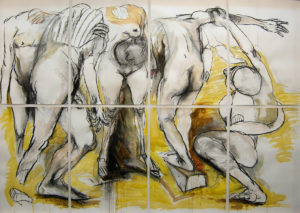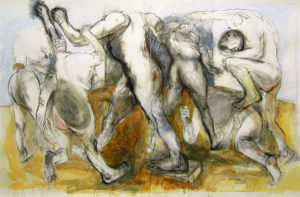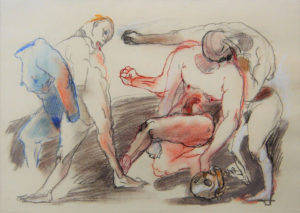The human being is constantly changing (at a mental, geographical, biological and affective level) and in recent years this reflection has acquired a new and dramatic actuality with the widespread phenomenon of migration, a consequence of the wars and economic disparities that afflict our globalized contemporaneity. The images conveyed by the media that document this unstoppable diaspora often place the emphasis on the fragile and indistinct physicality of expatriates in search of security and integration, strongly reviving a disturbing and unresolved vision of the body, incontrovertible proof of the tragedies of world inequality.
The Fragments exhibition, first Italian solo show by the Cuban artist Napoles Marty underway at Isolo 17 Gallery, takes these topics extremely sensitively, interpreting their suggestions in a universal and existential key. His research focuses on the depiction of choral scenes in which powerful but perpetually incomplete bodies fighting each other and with themselves to conquer an unattainable integrity. Their incongruences and mutilations, which become the object of a passionate and instinctive narration, must not be seen as decay and loss, but as a positive signal of metamorphosis that starts from the assumption of the impossibility of every final arrangement. In this way the formal violence of the image reflects a desperate desire to relate to the self and to the world, which from time to time takes on a tragic, erotic, surreal and ironic connotation.
On the walls of the first room of the gallery we find a series of monumental painted papers that immerse the observer in a visionary gipsoteca where groups of classically muscular herms deny the original sculptural composure to become opulent carnal encumbrances animated by blind survival instincts. Each gladiator clashes with the others in an attempt to appropriate the limbs they lack by taking them away from their opponents, but the effort always proves to be in vain because as soon as he seems about to reach the goal, another rival will be able to steal something from him and the fight will will go on forever. In this arena, with no holds barred, the possession of the heads always fewer than the number of wrestlers, is of vital importance and they are contended with fury and craving. In Napoles Marty’s drawings converge the most refined reminiscences of the history of the art, like the terrible of the figures of Michelangelo, the sense of “melee” as visceral interpenetration between individuals of the preparatory cartoons of the Battle of Anghiari by Leonardo da Vinci or the cult of the body by Luca Signorelli. But also the expressionist deformations of Schiele or the bubbling of Bacon’s flesh, all understood not as an intentional quotation but as belonging to a still lively artistic lineage that fosters the hope that in painting the body can continue to be rebellious and perturbing.
The natural plastic vocation of the drawings is embodied in the three sculptures on display, formed by disproportionate assemblages of human limbs in plaster whose physicality continues rough-hewn or drawn in the bases in wood summarily roughened with machetes. If in the drawings the vehemence of the contours traced with black is balanced by soft watercolor shades that allude to the vulnerability of the flesh, here the frangibility of the plaster (usually used in bronze statuary as a transitional material) finds complementarity in the strength and weight of the wood left unfinished. The incongruous creatures sculpted and modeled by the artist seem to materialize the provisional outcomes of the previous struggle as imperfect efforts to recompose an organic unity by putting together the disparate shreds of body that each character managed to grab in the battle disorder. Here too it will be impossible to trace a unique identity because each aggregate appears to be unstable and illogical, but precisely the precariousness of its mysterious balance is the main source of the force of attraction it exerts on the viewer.
In the second room of the exhibition, an entire wall is occupied by a mosaic of small-sized papers that reproduce the fight scenes depicted on a large scale in a more essential style. Here the theatricality and the drama of the previous works dissolves into more fluid compositions populated by a few characters freely suspended in the abstract space of the sheet. The evocative set of drawings seems to want to compose an ambiguous storyboard in which each episode, narratively disconnected from the others but emotionally similar, contributes to delineate a minor epic of the body committed to experimenting its impulses to try to understand and complete itself. Some elements appear to be numbered in pencil as if they had been taken from an irrationale anatomy manual, but the inconsistency of the indications eludes any claim to systematicity and solution. The changeability of these drawings also leads the eye into the intimacy of the artist’s creative process which, respecting the metamorphic nature of its subjects, does not force their evolution into a pre-determined scheme but is guided by their contradictory instances to comply them with sign and color
Info:
Napoles Marty. Fragments
Curated by Jessica Bianchera
March 15th – April 30th 2019
Isolo 17 Gallery
Via XX Settembre 31/b Verona




Graduated in art history at DAMS in Bologna, city where she continued to live and work, she specialized in Siena with Enrico Crispolti. Curious and attentive to the becoming of the contemporary, she believes in the power of art to make life more interesting and she loves to explore its latest trends through dialogue with artists, curators and gallery owners. She considers writing a form of reasoning and analysis that reconstructs the connection between the artist’s creative path and the surrounding context.






NO COMMENT